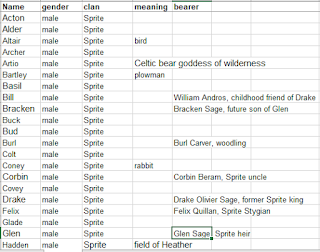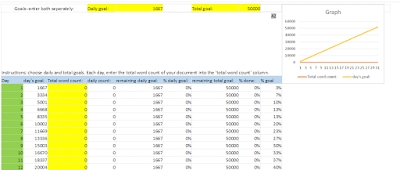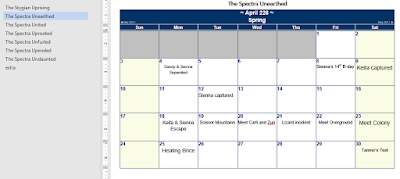Author of The Spectra Unearthed
One afternoon my college roommate, an accounting major, found me pouring over an excel sheet. “You use excel?” she asked incredulously.
“Yes,” I answered. “It’s useful for writing.”
She still stared at me. She didn't seem to believe that a wildlife conservation major with a perchance for fiction would be using the same program she used in her classes.
Excel can be a useful tool for the writer. In fact, I was using it as early as middle school for keeping track of my characters (and their Pokémon—this was 2000).
Here are some of the ways I use excel for writing fiction. Some of these are influenced by genre. I write fantasy and create my own world, so I need to keep track of more information than, say, a romance writer might. Others are useful no matter the genre.
Names


I did the same thing for agents before I decided to Indie publish, which also included columns for hints I’d dug up about the sort of books they were looking for.
Moneys
Now here’s the sheet that my accounting roommate would approve of! Where is money going and where is it coming from? It’s important to keep track! At the end of the year I move the total costs, total profits, and year total to another table so that I can compare years and look for patterns… and do taxes (shudder).

What, you don’t think I doctored the profits, do you?
Word Count
I must admit, I had to get my husband’s help to set this up. I participate in NaNoWriMo each year, and one of the most motivating parts is entering your wordcount into their tables and graphs. So we put together a table that can give that same motivation throughout the year, with adjustable goals (let me know if you want a copy and I can email it).

Not Excel, But Still Useful
Here are a few other useful files I keep for my books that are not on excel:
Calendar:

I chose to use ‘Word’ for the calendar, but excel would work just as well. This helps me keep track of the dates in my story. I have to make sure that events are realistically spread out, especially when my characters are traveling!

“Yes,” I answered. “It’s useful for writing.”
She still stared at me. She didn't seem to believe that a wildlife conservation major with a perchance for fiction would be using the same program she used in her classes.
Excel can be a useful tool for the writer. In fact, I was using it as early as middle school for keeping track of my characters (and their Pokémon—this was 2000).
Here are some of the ways I use excel for writing fiction. Some of these are influenced by genre. I write fantasy and create my own world, so I need to keep track of more information than, say, a romance writer might. Others are useful no matter the genre.
Names
“How do you name your characters?” comes up frequently in writing circles. I am something of a name enthusiast. I read name dictionaries and online lists for fun, and when I come up with one that fits my story, I add it to my name excel sheet. In The Spectra series, I go for names with meanings that tie in to that character’s clan. For instance, characters from the Cole clan have names meaning fire or red. The columns go across the top and then I fill in the information about each name. I include a column for “bearer” so I know if I’ve already used the name.
This way I can sort the names by gender and/or clan to help me narrow down the perfect name for my character. For instance, if a new male Sprite character appears, I can scroll down the alphabet to ‘S’…
This way I can sort the names by gender and/or clan to help me narrow down the perfect name for my character. For instance, if a new male Sprite character appears, I can scroll down the alphabet to ‘S’…
I also use excel to keep track of the history of my fantasy world. At the top, I have a column per year (around 300 years). This way I have a quick reference for births, deaths and marriages; important events in both kingdoms and characters’ lives; and the reigns of kings. I broke them up by clan to spread things out. It may be chaotic for someone who doesn’t know the world, but I can find what I need and that’s what’s important.
Characters

Characters

Have you ever read a series where one of the characters switches middle names between books? What about eyes that change color? Annoying, right? A character sheet on excel can be a great way to keep all those little details straight, especially for minor characters. You can add whatever details are most important to you. Here’s an example of mine (by the way, I hid the columns for spouse and children—too many spoilers!). I can sort by book in the series or parents/birth order if I’m looking at a whole family.
Chapter Length
This is a tool I use to help with pacing. I keep track of the name and number of each chapter, and then copy down the page numbers from my table of contents. This calculates the length of each chapter for me, so I can determine if parts are too long or two short, and compare one book in the series to another. Yes, all of the Keita’s Wings books have the same number of chapters—I find it a useful tool for book length, but if this is unappealing to you please don’t. I can be OCD about some of these things. The different colors on the chapter names are groupings I find useful, based off of characters and setting.
Agents and Reviews
I’ve also used excel to keep track of agents and reviewers that I’ve contacted about my books. For reviewers, I listed their name, website, when I submitted to them, and what response I received (information has been removed for privacy). I colored the rejections red and the accepted invitations green:
This is a tool I use to help with pacing. I keep track of the name and number of each chapter, and then copy down the page numbers from my table of contents. This calculates the length of each chapter for me, so I can determine if parts are too long or two short, and compare one book in the series to another. Yes, all of the Keita’s Wings books have the same number of chapters—I find it a useful tool for book length, but if this is unappealing to you please don’t. I can be OCD about some of these things. The different colors on the chapter names are groupings I find useful, based off of characters and setting.
Agents and Reviews
I’ve also used excel to keep track of agents and reviewers that I’ve contacted about my books. For reviewers, I listed their name, website, when I submitted to them, and what response I received (information has been removed for privacy). I colored the rejections red and the accepted invitations green:

I did the same thing for agents before I decided to Indie publish, which also included columns for hints I’d dug up about the sort of books they were looking for.
Moneys
Now here’s the sheet that my accounting roommate would approve of! Where is money going and where is it coming from? It’s important to keep track! At the end of the year I move the total costs, total profits, and year total to another table so that I can compare years and look for patterns… and do taxes (shudder).

What, you don’t think I doctored the profits, do you?
Word Count
I must admit, I had to get my husband’s help to set this up. I participate in NaNoWriMo each year, and one of the most motivating parts is entering your wordcount into their tables and graphs. So we put together a table that can give that same motivation throughout the year, with adjustable goals (let me know if you want a copy and I can email it).

Not Excel, But Still Useful
Here are a few other useful files I keep for my books that are not on excel:
Calendar:

I chose to use ‘Word’ for the calendar, but excel would work just as well. This helps me keep track of the dates in my story. I have to make sure that events are realistically spread out, especially when my characters are traveling!

Oh look, I left out a few death dates...
Family Trees
Main character Keita meets her cousins and other relatives in several of the Spectra books, so keeping track of them all is important. This information is on my excel timeline as well, but it’s handy to see them grouped by family in a linear, visual way. I have one of these for most of the major characters (including Keita’s mother’s side of the family on a separate sheet).
Maps

I have a ‘master map’ which shows the entire Spectra continent and all important places. This helps me get traveling dates straight (see calendar) and lets me visualize where the characters are and what directions they are facing. When I publish a book, I take the relevant section of my master map and turn it into an insert for the front of the book. Here’s the map that was included in book 3, The Spectra Uprooted: a map of the kingdom of Spritelands, and a small inset of the whole continent.
Various computer programs can be a real asset to your writing. These are the ones I’ve found the most useful. Feel free to try out any new ideas and let me know how they turned out!
Family Trees
Main character Keita meets her cousins and other relatives in several of the Spectra books, so keeping track of them all is important. This information is on my excel timeline as well, but it’s handy to see them grouped by family in a linear, visual way. I have one of these for most of the major characters (including Keita’s mother’s side of the family on a separate sheet).
Maps

I have a ‘master map’ which shows the entire Spectra continent and all important places. This helps me get traveling dates straight (see calendar) and lets me visualize where the characters are and what directions they are facing. When I publish a book, I take the relevant section of my master map and turn it into an insert for the front of the book. Here’s the map that was included in book 3, The Spectra Uprooted: a map of the kingdom of Spritelands, and a small inset of the whole continent.
Various computer programs can be a real asset to your writing. These are the ones I’ve found the most useful. Feel free to try out any new ideas and let me know how they turned out!






